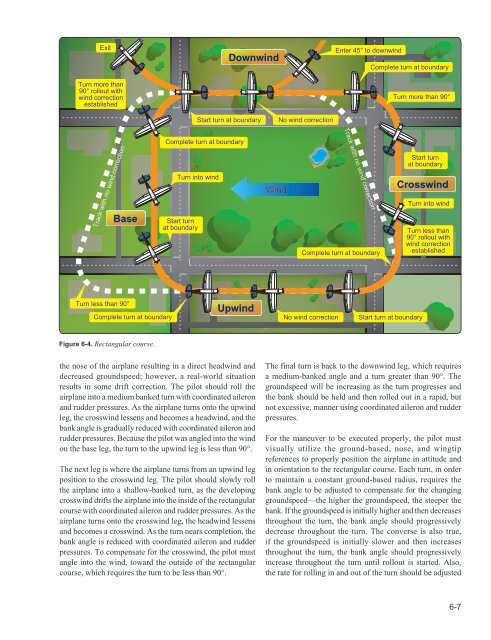Create successful ePaper yourself
Turn your PDF publications into a flip-book with our unique Google optimized e-Paper software.
Exit<br />
Turn more than<br />
90° rollout with<br />
wind correction<br />
established<br />
Downwind<br />
Enter 45° to downwind<br />
Complete turn at boundary<br />
Turn more than 90°<br />
Start turn at boundary<br />
No wind correction<br />
Base<br />
Track with no wind correction<br />
Complete turn at boundary<br />
Turn into wind<br />
Start turn<br />
at boundary<br />
Wind<br />
Track with no wind correction<br />
Complete turn at boundary<br />
Start turn<br />
at boundary<br />
Crosswind<br />
Turn into wind<br />
Turn less than<br />
90° rollout with<br />
wind correction<br />
established<br />
Turn less than 90°<br />
Complete turn at boundary<br />
Upwind<br />
No wind correction<br />
Start turn at boundary<br />
Figure 6-4. Rectangular course.<br />
the nose of the airplane resulting in a direct headwind and<br />
decreased groundspeed; however, a real-world situation<br />
results in some drift correction. The pilot should roll the<br />
airplane into a medium banked turn with coordinated aileron<br />
and rudder pressures. As the airplane turns onto the upwind<br />
leg, the crosswind lessens and becomes a headwind, and the<br />
bank angle is gradually reduced with coordinated aileron and<br />
rudder pressures. Because the pilot was angled into the wind<br />
on the base leg, the turn to the upwind leg is less than 90°.<br />
The next leg is where the airplane turns from an upwind leg<br />
position to the crosswind leg. The pilot should slowly roll<br />
the airplane into a shallow-banked turn, as the developing<br />
crosswind drifts the airplane into the inside of the rectangular<br />
course with coordinated aileron and rudder pressures. As the<br />
airplane turns onto the crosswind leg, the headwind lessens<br />
and becomes a crosswind. As the turn nears completion, the<br />
bank angle is reduced with coordinated aileron and rudder<br />
pressures. To compensate for the crosswind, the pilot must<br />
angle into the wind, toward the outside of the rectangular<br />
course, which requires the turn to be less than 90°.<br />
The final turn is back to the downwind leg, which requires<br />
a medium-banked angle and a turn greater than 90°. The<br />
groundspeed will be increasing as the turn progresses and<br />
the bank should be held and then rolled out in a rapid, but<br />
not excessive, manner using coordinated aileron and rudder<br />
pressures.<br />
For the maneuver to be executed properly, the pilot must<br />
visually utilize the ground-based, nose, and wingtip<br />
references to properly position the airplane in attitude and<br />
in orientation to the rectangular course. Each turn, in order<br />
to maintain a constant ground-based radius, requires the<br />
bank angle to be adjusted to compensate for the changing<br />
groundspeed—the higher the groundspeed, the steeper the<br />
bank. If the groundspeed is initially higher and then decreases<br />
throughout the turn, the bank angle should progressively<br />
decrease throughout the turn. The converse is also true,<br />
if the groundspeed is initially slower and then increases<br />
throughout the turn, the bank angle should progressively<br />
increase throughout the turn until rollout is started. Also,<br />
the rate for rolling in and out of the turn should be adjusted<br />
6-7


